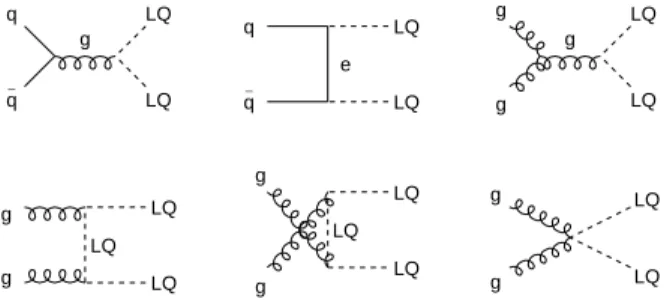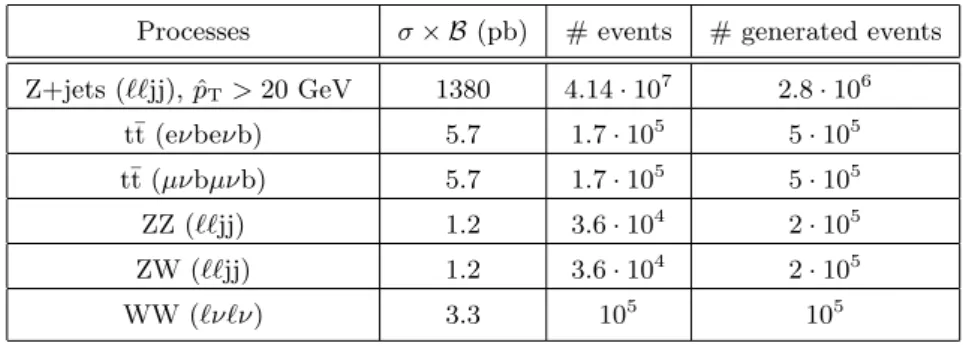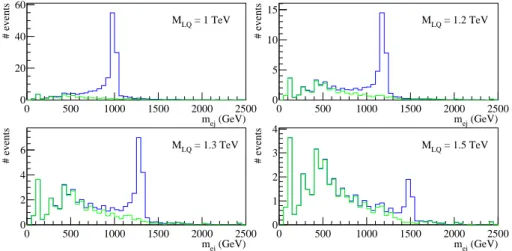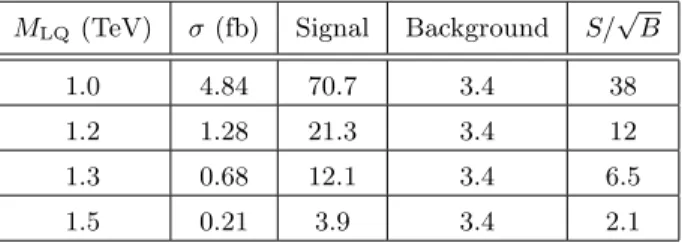Prospects for Scalar Leptoquark Discovery at the LHC
V. A. Mitsou
∗)
Instituto de F´ısica Corpuscular (IFIC), CSIC - Universitat de Val`encia, Valencia, Spain
N. Ch. Benekos
Max-Planck-Institut f¨ ur Physik, Munich, Germany
I. Panagoulias, Th. D. Papadopoulou Faculty of Applied Mathematics and Physics, National Technical University of Athens, Athens, Greece
Received 12 November 2004;
. The discovery potential of the ATLAS detector for scalar leptoquark pair production at the LHC is discussed in this paper. The study is performed using a parameterized yet realistic simulation of the ATLAS detector response for the signal and the background.
The channel LQ LQ → (`q)(`q), where ` = e, µ, is investigated for the first two generations and the decay mode LQ LQ → (ν
τb)(ν
τb) for the third one. In both cases, a preliminary mass reach is found to be ∼ 1.3 TeV for three years of LHC running at low luminosity.
PACS : 12.60.-i, 13.85.Rm, 14.80.-j
Key words: LHC, ATLAS, leptoquarks, scalar, pair production
1 Introduction and phenomenology
Among possible new particles in physics beyond the Standard Model, lepto- quarks (LQs) are an interesting category of exotic colour triplets with couplings to quarks and leptons. They are a generic prediction of Grand Unified Theories [1], of composite models [2], of technicolor schemes [3], of superstring-inspired E
6models [4], and of supersymmetry with R-parity violation [5].
Leptoquarks are colour triplets which couple to quarks and leptons via a Yukawa- type coupling, λ, conserving the baryon and lepton numbers. In the model of Buchm¨ uller, R¨ uckl and Wyler (BRW) [6], leptoquarks couple to a single generation of Standard Model (SM) fermions via chiral Yukawa couplings which are invariant under the SU(3)
C× SU(2)
L× U(1)
Ysymmetry group. Inter-generational mixing is not allowed since neither flavour-changing neutral currents nor lepton flavour vio- lation, induced by this mixing, have been observed so far. Moreover, leptoquarks coupling to both left- and right-handed electrons would mediate rare decays [7], hence leptoquarks couplings are assumed to be chiral.
There exist 14 species
1) of leptoquarks, differing by their spin (scalars or vec- tors), fermion number F = 3B +L, isospin and chirality of the coupling. They have
∗
) Corresponding author; e-mail: Vasiliki.Mitsou@cern.ch
1
) If the assumption of chiral couplings is dropped, this number reduces to ten.
fractional electric charge (±5/3, ±4/3, ±2/3 and ±1/3) and decay into a charged or neutral lepton and a quark, according to the decay modes LQ → `q and LQ → νq.
In the most commonly used notation, F = 0 scalar (S) and vector (V ) species are denoted as S
1/2L, S
1/2R, ˜ S
1/2, V
0L, V
0R, ˜ V
0and V
1, while the F = 2 species are S
0L, S
0R, ˜ S
0, S
1, V
1/2L, V
1/2Rand ˜ V
1/2 2). Decay widths for scalar and vector LQs of mass M
LQare given by λ
2M
LQ/16π and λ
2M
LQ/24π, respectively. The leptoquark branching fractions β ≡ B(LQ → `q) are predicted by the BRW model and take the values 1, 0.5 and 0.
In the following we consider pair production of scalar leptoquarks, which pro- ceeds through gg fusion and q¯q annihilation via the diagrams shown in Fig. 1. The production cross section is only slightly dependent on λ, since it is dominated by gg fusion which does not involve the `−q−LQ coupling. Therefore the cross section is not strongly sensitive to the quark and lepton flavours to which the LQ couples, implying that all species are produced at almost the same rate. More information on LQ production at hadron colliders can be found in Ref. [8].
q− q
g LQ
LQ q
e
q− LQ
LQ
g g
g LQ
LQ
g
LQ
g LQ
LQ
g LQ g
LQ
LQ g
g LQ
LQ
Fig. 1. Leading-order diagrams of leptoquark pair production at LHC.
2 Exclusion limits
The current bounds on leptoquark production are set from Tevatron [9], LEP [10] and HERA [11]. For first generation LQs, the Tevatron experiments have set limits on scalars (coupling to eq) of M
LQ> 242 GeV and corresponding vector LQ limits in the range from 233 to 345 GeV, depending on model assumptions. For LQs coupled to νq the limit is set to 117 GeV. The LEP experiments have set bounds on M
LQ(approximately proportional to λ) which range from 165 to 917 GeV for λ = √
4πα
em' 0.3. The HERA experiments have set lower mass limits in the range of ∼ 250 to 280 GeV for λ = 0.1. In addition, searches at the Tevatron and LEP have constrained leptoquarks coupled to leptons and quarks of the second and third generations.
2
) Superscripts denote the chirality and subscripts indicate the isospin of the particles.
3 Event and detector simulation
In this study both the signal and the background events are generated with the event generator PYTHIA 6.2 [12], which provides a leading-order calculation of the LQ production cross section. The CTEQ5M set is used for the parton distribution functions and initial- and final-state radiation is switched on. As far as the Yukawa coupling is concerned, we set λ = √
4πα
em' 0.3, leading to a total decay width of Γ ∼ 2 GeV for M
LQ= 1 TeV. This width is overwhelmed by the calorimeter resolution precluding any measurement of it, yet it allows one to treat the lepto- quark as a resonance, i.e. it decays before fragmentation and only the products of its decay are observed in the detector. Hence the results obtained in this study are insensitive to λ as long as its value is consistent with resonant LQs, i.e. λ & 10
−6for M
LQ& 1 TeV.
The performance of the ATLAS detector [13] was simulated with the fast simula- tion package ATLFAST [14]. This simulation includes, in a parameterized way, the main aspects related to the detector response: jet reconstruction in the calorime- ters, momentum/energy smearing for leptons and photons, reconstruction of miss- ing transverse energy and charged particles. It is tuned to reproduce as well as possible the expected ATLAS performance [15].
4 Leptons plus jets channel (``jj)
We have considered pair production of scalar leptoquarks of the first two gener- ations. Both LQs are assumed to decay to a charged lepton and a quark, providing a topology with two high-p
Tleptons and two high-E
Tjets. Potential bounds in LQ mass are obtained for leptoquarks with branching ratio β = 1 or β = 0.5.
4.1 Background
The background processes considered are characterized by the presence of two iso- lated high-p
Tleptons and at least two jets in the final state. Before applying any cuts the main background source is the QCD processes. Nevertheless this is elim- inated completely after the requirement for two isolated high-p
Tleptons and in particular after selecting events with high lepton-jet reconstructed invariant mass, m
`j. The Drell-Yan lepton pair production, q¯q → γ
∗/Z → `
+`
−, is another possi- ble background source but not as important for the LHC (pp collider) as it is for Tevatron (p¯ p collider). It can be eliminated in a similar manner after the high-m
`jcut is applied.
The cross sections of the surviving background processes are given in Table 1.
The production of two leptons and two jets in the final state has been forced in
PYTHIA. For processes with large cross section, such as Z+jet and t¯t, the genera-
tion production has been divided in several ˆ p
Tintervals.
Table 1. Cross section, expected number of events for L = 30 fb
−1and number of generated events of background processes for the LQ LQ → ``jj channel.
Processes σ × B (pb) # events # generated events Z+jets (``jj), ˆ p
T> 20 GeV 1380 4.14 · 10
72.8 · 10
6t¯t (eνbeνb) 5.7 1.7 · 10
55 · 10
5t¯t (µνbµνb) 5.7 1.7 · 10
55 · 10
5ZZ (``jj) 1.2 3.6 · 10
42 · 10
5ZW (``jj) 1.2 3.6 · 10
42 · 10
5WW (`ν`ν) 3.3 10
510
54.2 Analysis
A first level of cuts is applied, requiring exactly two same-flavour, opposite-sign leptons with p
T> 30 GeV and |η| < 2.5, and at least two jets with E
T> 30 GeV and |η| < 5, for both signal and background, in order to identify the kinematic vari- ables sensitive to the signal. Furthermore the selection criteria were optimized so that a significance over 5σ is achieved for the maximum possible leptoquark mass, retaining at the same time at least ten signal events for an integrated luminosity of 30 fb
−1. The final cuts for both eejj and µµjj channels are the following: two same- flavour, opposite-sign leptons with p
T> 100 GeV and |η| < 2.5; at least two jets with E
T> 70 GeV and |η| < 5; invariant mass of the two leptons m
``> 180 GeV, to exclude events from the Z → `` peak; E
missT< 70 GeV, to suppress the t¯t back- ground; sum of transverse energy deposited in the calorimeters P
E
caloT> 570 GeV;
ratio E
missT/ P
E
caloT< 0.05 and a mass window |m
`j−M
LQ| < 100 GeV. In the m
`jdistribution, only the two leading jets and the two leptons are taken into account in the mass reconstruction. Moreover, between the two possible combinations, the one providing the minimum difference between the obtained values of m
`jis chosen.
The obtained m
ejdistributions for the signal and the background, after apply- ing the final cuts, are shown in Fig. 2 for various leptoquark masses and for the eejj channel. The cross section, the corresponding numbers of events in the mass win- dow, as well as the significance achieved, are listed in Table 2 for a branching ratio of β = 1. The distributions are normalized to an integrated luminosity of 30 fb
−1, expected to be collected after three years of LHC running at low luminosity.
Signal can be clearly observed over the background for up to M
LQ' 1.3 TeV.
For larger LQ masses, although the analysis is practically background-free, the low statistics preclude any potential observation of signal. Production cross section for the second generation (µµjj channel), is about 2% lower, however, similar results are obtained.
The leptoquarks studied so far decay with β = 1 and correspond to the following
particles: S
R0(−1/3), ˜ S
0(−4/3), S
L1/2(−5/3), S
R1/2(−5/3), S
R1/2(−2/3), ˜ S
1/2(−2/3), S
1(−4/3)
3). In the case of leptoquarks with β = 0.5, i.e. S
L0(−1/3), S
1(−1/3), the previous limit becomes less stringent; leptoquarks are observable for M
LQ. 1 TeV with a significance of S/ √
B ' 15 at M
LQ= 1 TeV. However this bound can be enhanced by searching for LQs in the LQ LQ → `νqq
0channel.
mej (GeV)
# events
mej (GeV)
# events
mej (GeV)
# events
mej (GeV)
# events
MLQ = 1 TeV MLQ = 1.2 TeV
MLQ = 1.3 TeV MLQ = 1.5 TeV
0 20 40 60
0 500 1000 1500 2000 2500 0
5 10 15
0 500 1000 1500 2000 2500
0 2 4 6
0 500 1000 1500 2000 2500 0
1 2 3 4
0 500 1000 1500 2000 2500
Fig. 2. m
ejdistributions for background (light green line) and signal plus background (dark blue line), for various values of LQ mass and for an integrated luminosity of 30 fb
−1.
Table 2. Signal (1
stgeneration) cross section, number of signal and background events and significance for the eejj channel, for various values of LQ mass and for L = 30 fb
−1.
M
LQ(TeV) σ (fb) Signal Background S/ √ B
1.0 4.96 98.5 2.84 58
1.2 1.33 22.0 2.43 14
1.3 0.713 12.8 1.44 11
1.5 0.223 3.62 0.376 5.9
5 Missing energy plus jets channel (ννjj)
In the LQ LQ → ννqq channel, both LQs are assumed to decay to a neutrino and a quark, providing a topology with two high-E
Tjets and large missing transverse energy, E
missT. For the first two generations, the (huge) Z+jet (ννjj) background is
3
) The numbers in parenthesis represent the electric charge of the particles.
irreducible making thus the analysis unfeasible. In contrast, for a third-generation leptoquark coupled to ν
τb, the b-tagging capabilities of the ATLAS detector allow the signal to be disentangled from this background. Species with this coupling are studied in the following. The branching ratio of the decay B(LQ → νb) = 1 − β is taken to be equal to 1 or 0.5.
The standard ATLFAST b-tagging performance is assumed, i.e. a b-tagging efficiency of 50% with a fake rate of 9% for c-quarks and 0.043% for light quarks.
p
T-dependent correction factors are also included.
5.1 Background
Besides the Z+jet (ννjj) production, main background sources are the t¯t (`νb`νb, τ νbτ νb), ZZ (ννbb) and ZW (bb`ν, bbτ ν) processes. All other processes, listed in Table 3, are eliminated by the b-tagging and the lepton veto.
Table 3. Cross section, expected number of events for L = 30 fb
−1and number of generated events of background processes for the LQ LQ → ννbb channel.
Processes σ × B (pb) # events # generated events Z+jets (ννjj) 22 000 6.6 · 10
87.5 · 10
5W+jets (`νbb, τ νbb) 28 400 8.5 · 10
81.5 · 10
5t¯t (`νb`νb, τ νbτ νb) 51.6 1.5 · 10
65 · 10
5ZZ (νν bb) 0.6 1.8 · 10
410
5ZW (bb`ν, bbτ ν) 1.3 4 · 10
410
5ZW (ννjj) 3.6 10
510
5WW (`νjj, τ νjj) 30.5 9 · 10
510
55.2 Analysis
Since in this channel leptoquarks decay to a τ -neutrino and a b-quark, producing two undetectable particles, the leptoquark mass is not reconstructed, and therefore only an excess of events can be observed. The different topology between signal and background events is taken into account by means of jet separation angles.
Nevertheless, the signal selection can be improved if event shape variables, such as sphericity and aplanarity, are employed.
The final cuts applied to the event samples are the following: at least two jets
tagged as originating from b-quarks with E
T> 70 GeV and |η| < 5; missing trans-
verse energy E
Tmiss> 400 GeV; veto on isolated leptons for suppression of W+jets
and t¯t background; and m
jj> 180 GeV. In addition, since the two leptoquarks
are produced back-to-back, the angular distribution of the final states should be
constrained. Hence the azimuthal angle between the two leading jets is required to be 30
◦< ∆φ
j−j< 150
◦, and the azimuthal angle between each of the two leading jets and the missing transverse momentum is selected to be ∆φ
j−pmissT




